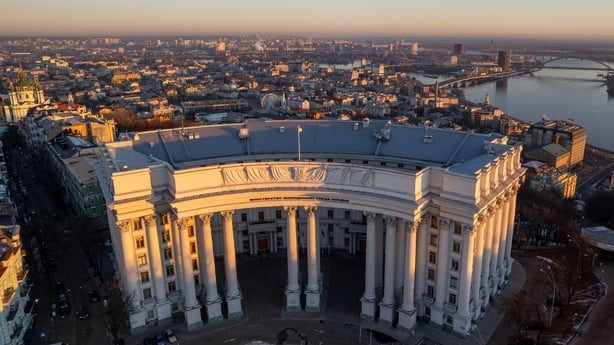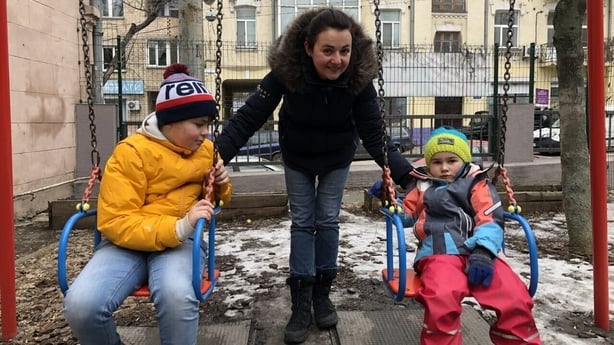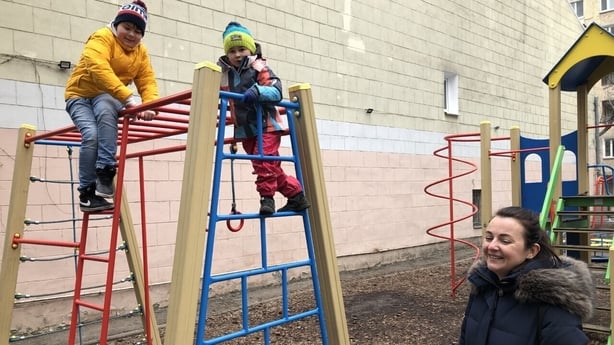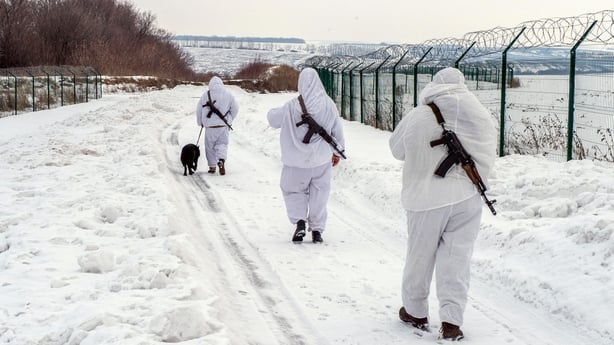On Maidan Square, at the entrance to the Globus 2 shopping mall, teenagers gather in the early evening to listen to booming techno and drink vodka mixed with fruit juice in the icy twilight.
All around the square, for decades a hub for political activity, there are monuments to Ukrainian heroes and figureheads, including the memorial to the Heavenly Hundred, the 107 protestors shot dead by security forces during the violent Euromaidan upheavals of February 2014.
Khreschatyk Street, which cuts through Maidan, is busy with traffic and office workers going home past fast-food stalls and glittering shop fronts.
Off the main boulevard a waitress struggles to light 24 candles on a cake before carrying it through to the birthday boy and his friends in the vaulted downstairs of the Bochka Pub.
A screaming electric guitar version of Happy Birthday prompts raucous cheers. In a room off the main bar there is a loud pub quiz going on, and upstairs in the smoking section people are watching Real Madrid versus PSG on big screens.
Kyiv, in other words, does not look like a city bracing itself for Russian tanks.

Around the Ukrainian capital life seems normal. Supermarkets and malls are returning to bustling activity following months of Covid lockdown. There are no signs of panic buying or empty shelves.
However, shops selling hunting guns and tactical gear are reportedly doing a brisk trade.
Asked if they fear an invasion, most Kyivans will tell you they have been living with invasion since 2014, when Russia seized Crimea and poured weapons and resources into the self-declared pro-Moscow republics of Luhansk and Donetsk in the east.
"We have been living in a state of invasion for the past eight years," says Yuri Hudymenko, a member of Democratic Axe, a crowdfunded and radically libertarian political party.
"Maybe Russia will move its troops back from the Belarus border, but they still have troops in Ukrainian Donetsk, in Ukrainian Luhansk, in Ukrainian Crimea.
"Invasion hasn't stopped in the past eight years. War is ongoing, war is continuous."
Many families have already left for Lviv and other parts of Western Ukraine. Others are watching developments anxiously before deciding on what to do.
Olga Ishyna, a 40-year-old mother of two who works in a film production company, has a suitcase packed and is ready to drive the family to her mother's place in Zhytomyr, a province in northern Ukraine 100km from Kyiv.

Olga and her husband Eugen have prepared documents, money and a first aid kit.
"We are not afraid, we are prepared. We have plans for different scenarios. We’ll stay there for a while and see what happens, how the situation will proceed," she says.
Her greatest fear is an aerial bombardment of the capital. "I really don't believe that this can happen. But it is my deepest concern."
The authorities have been taking such risks seriously and underground carparks have been designated as bomb shelters.
Olga’s five-year-old daughter Marichka was given a tour of one such carpark by teachers in her creche. They’ve been preparing first-aid kits and stockpiling water supplies.

"They have already had a small tour [of the underground carpark] for the little kids to inform them," says Olga.
"It was an entertaining excursion. So they know where they will go, why they go there, and what they should do. The parents are well informed as to where they can get their children in the case of an emergency or if there is a siren, which means an attack from the air."
Russia insists it has no plans for an invasion, and has dismissed such warnings as Western hysteria.
At the same time Moscow has massed up to 140,000 troops on Ukraine’s borders, mobilising huge volumes of frontline fighting troops and supply line equipment right down to refuelling and blood transfusion capabilities.
Olga is most worried about Eugen junior, her 10-year-old. "He speaks to his friends at school, they read social media, they're concerned. But I'd like to thank the teachers and psychologists in the school. They also talk to the children and try to calm them down."

There is a defiant mood as well. The Ukrainian Territorial Defense Force has been running more intensive training sessions and workshops for citizens on how to prepare for a potential invasion.
Valentyna Konstantynovska, a 79-year-old great-grandmother, found herself on the front pages of global newspapers when a picture emerged of her being shown how to use an AK47 in the eastern port city of Mariupol.
"People have really been trained in, and you've seen that more overtly in the last couple of weeks," says one Western source, "where people are doing workshops at weekends about how to conduct yourself if you did have to pick up a rifle."
Two joint committees of the Verkhovna Rada, Ukraine’s Supreme Parliament, briefed diplomats yesterday that the government was intent on seeking a peaceful resolution to the crisis, but if the country was attacked the government was prepared for all eventualities.
There has been a difference in opinion between Kyiv and Washington over Russia’s preparedness for a full-scale invasion, including an assault on the capital.
The Ukrainian government’s interpretation, according to sources, is that while there are large numbers of Russian troops to the north in Belarus, supposedly the launch point for a strike against the capital, those troops would have to travel through very marshy terrain, and the capital would also be "fiercely guarded".
While largely outmanned and outgunned by Russia, Ukraine has improved its training and defensive capabilities in recent years.
The chances of an invasion are still high, and while the fog of rhetoric and signalling between Russia and West obscures any sense of how the crisis will play out, ordinary citizens are having to take difficult decisions.
On Saturday 12 February, the Irish Department of Foreign Affairs changed its travel advice, urging Irish citizens in Ukraine to leave the country.
⚠️ Updated Travel Advice for Ukraine. @dfatirl advises against all travel to Ukraine. Irish citizens in Ukraine are advised to depart immediately by commercial means @IrlEmbUkraine.
— DFATravelWise (@dfatravelwise) February 12, 2022
ℹ️ https://t.co/ctwbQvAmnC
A new Irish embassy was established in Kyiv in June of last year (its opening was delayed by the pandemic) and consular staff there are getting to grips with the profile of the Irish community in Ukraine, which has not to date had a natural centre of gravity to gather around (the country had previously been handled by the Irish embassy in Prague).
Many of the Irish in Ukraine are professionals, English-language teachers, or have moved to Ukraine to work in the burgeoning IT and AgriTech sectors, sometimes drawn to the country after the Orange Revolution in 2004, when the economy started to pick up.
So far around 150 Irish citizens (and dual nationals) have registered with the embassy, those mainly living in Kyiv and Lviv, but others are clustered here and there across the vast countryside.
Some 30 Irish people, including those with small children, have heeded the advice and left the country, mostly by air.
Others, especially who have Ukrainian spouses or partners, have assumed the stoical, wait-and-see approach that pervades the capital.
The ambassador, Therese Healy, is understood to be intensifying the outreach to Irish citizens across Ukraine, encouraging people to register with the embassy in order to ensure that any Irish citizen or dual national can get the guidance and help they need if hostilities break out.
Olga Isyna has said she and her family will leave for the European Union if an invasion happens and Kyiv falls, with the Kremlin installing a puppet government.
It is still hard, dizzying even, to walk through the busy streets of Kyiv and picture Russian tanks rolling in, as they did in Budapest in 1956 and Prague in 1968.
But ordinary Kyivans have to make their choices. "If Ukraine, or [another] part of Ukraine loses its sovereignty and independence, that’s when we will go abroad," says Olga.







